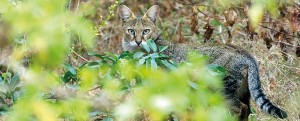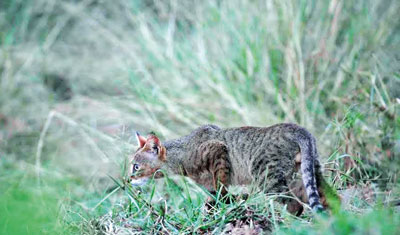The forgotten feline
View(s):By Purnima Pilapitiya
The first time Dr. Sriyanie Miththapala saw a jungle cat was in the Uda Walawe national park. But in a flash, the elusive, long-limbed feline with its signature black-tipped ears was gone swallowed by the golden green grasslands. Hoping to uncover the story behind one of Sri Lanka’s lesser known cats is the “Jungle Cat Sri Lanka project” initiated by Dr. Miththapala. “Sri Lanka’s focus is on the big animal,” she explains.
The sandy coloured feline is not among the endangered species lists. Its distribution ranges from Northern Africa, Central and Southeast Asia and Southern China.Weighing between 5-8 kg, the Jungle Cat stands out among the four species of wild cat found in the country (along with leopard, Fishing cat and Rusty spotted cat). Its distinctively lean, long-limbed body with tufts on its almost butterfly-winged ears is difficult to ignore, even harder to spot, explains Dr. Miththapala.
Her fascination with the largely overlooked jungle cat doesn’t come as a surprise. Dr. Miththapala’s passion for wildlife and her soft spot for the big cat family rewind back to her childhood and her nature-loving father. She describes him as “an avid bird watcher” who encouraged his children to observe and appreciate nature even within the limitations of their home garden.

Pic by Rajiv Welikala
“Biology was always on the cards,” she says frankly. She would graduate in Biology from the University of Colombo followed by her MA in Biology from Smith College, USA, and PhD in Wildlife and Range Sciences from the University of Florida, USA. Having chosen the Sri Lankan leopard as the subject of her doctoral dissertation, her groundbreaking research would go onto pioneer novel methods of identifying individual leopards by their spot patterns and placing the Sri Lankan leopard as a unique subspecies.
At the 2015 symposium of “Wild Cats of South Asia, past and present” she observed that although research is being conducted on the Sri Lankan leopard and the fishing cat, there were no attempts to study the elusive and little known jungle cat (Felis chaus) . Her idea to investigate the local distribution of the jungle cat was then stimulated by curiosity and concern. “We have no idea whether this is a cat of the dry zone or not,” she explains, “or whether this is a common or rare cat. It has been observed around towns in Anuradhapura and Trincomalee.”
The Jungle Cat Sri Lanka project began in October this year, funded by the Mohamed bin Zayed Species Conservation Fund- a philanthropic organization supporting conservationists from all over the world. What the project needed now was the support of wildlife enthusiasts with a passion toward helping the project succeed. Inspired by the passionate response of the public on social media toward 2015’s devastating floods, she launched an email campaign and a Facebook page.
 Dr. Miththapala and her collaborator Niroshan Mirando, a software engineer built the website(http://junglecatsrilanka.com/), and have called upon wildlife enthusiasts to submit photographs of jungle cats with the location at which the picture was taken. The pictures (duly credited) will be added to the currently known distribution map of the jungle cat. Next, this map will be overlaid with a map of land use and of Sri Lanka’s unique reservoirs, to identify which habitats are used by the jungle cat. Once there is a better distribution map of this species, a tailored strategy to understand its ecology, behaviour and threats to its survival, as well as conservation actions, can be formulated.
Dr. Miththapala and her collaborator Niroshan Mirando, a software engineer built the website(http://junglecatsrilanka.com/), and have called upon wildlife enthusiasts to submit photographs of jungle cats with the location at which the picture was taken. The pictures (duly credited) will be added to the currently known distribution map of the jungle cat. Next, this map will be overlaid with a map of land use and of Sri Lanka’s unique reservoirs, to identify which habitats are used by the jungle cat. Once there is a better distribution map of this species, a tailored strategy to understand its ecology, behaviour and threats to its survival, as well as conservation actions, can be formulated.
“Even though Sri Lanka has been at the forefront of Red Listing in the Asian region, we have not progressed beyond this process. Although we have identified species that need urgent conservation intervention, actual conservation actions related to such species have not kept pace with the generation of Red Lists. Similarly, our taxonomic studies in the last few decades have been excellent; however, our knowledge about the ecology of such species is not adequate. Although the jungle cat is listed as Near Threatened (NT) in Sri Lanka, we have no targeted knowledge in Sri Lanka about its ecology, behaviour and scant, often incidental knowledge of its distribution. If, as noted by researchers in other countries, this cat is associated with habitats near rivers, then Sri Lanka’s Dry Zone is unique because it is dotted with nearly 10,000 ancient irrigation reservoirs, relics of an ancient hydraulic civilization providing perennial and seasonal sources of water for many species, so in fact the distribution of the jungle cat may well be very different than actually portrayed in the current distribution map,” says Dr. Miththapala.
Please visit http://junglecatsrilanka.com/ and Facebook page “Jungle Cat Sri Lanka” for more details.


